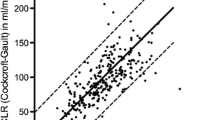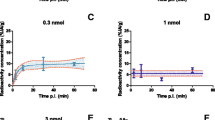Abstract
Purpose
In peptide receptor radionuclide therapy (PRRT) using radiolabelled somatostatin analogues, the kidneys are the major dose-limiting organs, because of tubular reabsorption and retention of radioactivity. Preventing renal uptake or toxicity will allow for higher tumour radiation doses. We tested the cytoprotective drug amifostine, which selectively protects healthy tissue during chemo- and radiotherapy, for its renoprotective capacities after PRRT with high-dose [177Lu-DOTA0,Tyr3]octreotate.
Methods
Male Lewis rats were injected with 278 or 555 MBq [177Lu-DOTA0,Tyr3]octreotate to create renal damage and were followed up for 130 days. For renoprotection, rats received either amifostine or co-injection with lysine. Kidneys, blood and urine were collected for toxicity measurements. At 130 days after PRRT, a single-photon emission computed tomography (SPECT) scan was performed to quantify tubular uptake of 99mTc-dimercaptosuccinic acid (DMSA), a measure of tubular function.
Results
Treatment with 555 MBq [177Lu-DOTA0,Tyr3]octreotate resulted in body weight loss, elevated creatinine and proteinuria. Amifostine and lysine treatment significantly prevented this rise in creatinine and the level of proteinuria, but did not improve the histological damage. In contrast, after 278 MBq [177Lu-DOTA0,Tyr3]octreotate, creatinine values were slightly, but not significantly, elevated compared with the control rats. Proteinuria and histological damage were different from controls and were significantly improved by amifostine treatment. Quantification of 99mTc-DMSA SPECT scintigrams at 130 days after [177Lu-DOTA0,Tyr3]octreotate therapy correlated well with 1/creatinine (r 2=0.772, p<0.001).
Conclusion
Amifostine and lysine effectively decreased functional renal damage caused by high-dose [177Lu-DOTA0,Tyr3]octreotate. Besides lysine, amifostine might be used in clinical PRRT as well as to maximise anti-tumour efficacy.





Similar content being viewed by others
References
Kwekkeboom DJ, Mueller-Brand J, Paganelli G, Anthony LB, Pauwels S, Kvols LK, et al. Overview of results of peptide receptor radionuclide therapy with 3 radiolabeled somatostatin analogs. J Nucl Med 2005;46:62S–6S.
Waldherr C, Pless M, Maecke HR, Schumacher T, Crazzolara A, Nitzsche EU, et al. Tumor response and clinical benefit in neuroendocrine tumors after 7.4 GBq 90Y-DOTATOC. J Nucl Med 2002;43:610–6.
Kwekkeboom DJ, Teunissen JJ, Bakker WH, Kooij PP, de Herder WW, Feelders RA, et al. Radiolabeled somatostatin analog [177Lu-DOTA0,Tyr3]octreotate in patients with endocrine gastroenteropancreatic tumors. J Clin Oncol 2005;23:2754–62.
Teunissen JJ, Kwekkeboom DJ, Krenning EP. Quality of life in patients with gastroenteropancreatic tumors treated with [177Lu-DOTA0,Tyr3]octreotate. J Clin Oncol 2004;22:2724–9.
Valkema R, Pauwels S, Kvols LK, Barone R, Jamar F, Bakker WH, et al. Survival and response after peptide receptor radionuclide therapy with [90Y-DOTA0,Tyr3]octreotide in patients with advanced gastroenteropancreatic neuroendocrine tumors. Semin Nucl Med 2006;36:147–56.
Duncan JR,Welch MJ. Intracellular metabolism of indium-111-DTPA-labeled receptor targeted proteins. J Nucl Med 1993;34:1728–38.
Barone R, Borson-Chazot F, Valkema R, Walrand S, Chauvin F, Gogou L, et al. Patient-specific dosimetry in predicting renal toxicity with 90Y-DOTATOC: relevance of kidney volume and dose rate in finding a dose-effect relationship. J Nucl Med 2005;46:99S–106S.
De Jong M, Kwekkeboom D, Valkema R, Krenning EP. Radiolabelled peptides for tumour therapy: current status and future directions. Plenary lecture at the EANM 2002. Eur J Nucl Med Mol Imaging, 2003;30:463–9.
Emami B, Lyman J, Brown A, Coia L, Goitein M, Munzenrider JE, et al. Tolerance of normal tissue to therapeutic irradiation. Int J Radiat Oncol Biol Phys 1991;21:109–22.
De Jong M, Rolleman EJ, Bernard BF, Visser TJ, Bakker WH, Breeman WA, et al. Inhibition of renal uptake of indium-111-DTPA-octreotide in vivo. J Nucl Med 1996;37:1388–92.
Rolleman EJ, Valkema R, De Jong M, Kooij PP, Krenning EP. Safe and effective inhibition of renal uptake of radiolabelled octreotide by a combination of lysine and arginine. Eur J Nucl Med Mol Imaging 2003;30:9–15.
Barone R, Pauwels S, De Camps J, Krenning EP, Kvols LK, Smith MC, et al. Metabolic effects of amino acid solutions infused for renal protection during therapy with radiolabelled somatostatin analogues. Nephrol Dial Transplant 2004;19:2275–81.
Bodei L, Cremonesi M, Zoboli S, Grana C, Bartolomei M, Rocca P, et al. Receptor-mediated radionuclide therapy with 90Y-DOTATOC in association with amino acid infusion: a phase I study. Eur J Nucl Med Mol Imaging 2003;30:207–16.
Rolleman EJ, Bernard B, De Visser M, Bijster M, Visser TJ, Vermeij M, et al. Long term toxicity of [177Lu-DOTA0,Tyr3]octreotate in rats. Eur J Nucl Med Mol Imaging 2006 Sep 22; [Epub ahead of print].
Cohen EP, Robbins ME. Radiation nephropathy. Semin Nephrol 2003;23:486–99.
Andreassen CN, Grau C, Lindegaard JC. Chemical radioprotection: a critical review of amifostine as a cytoprotector in radiotherapy. Semin Radiat Oncol 2003;13:62–72.
Calabro-Jones PM, Fahey RC, Smoluk GD, Ward JF. Alkaline phosphatase promotes radioprotection and accumulation of WR-1065 in V79-171 cells incubated in medium containing WR-2721. Int J Radiat Biol Relat Stud Phys Chem Med 1985;47:23–7.
Capizzi R. Amifostine: the preclinical basis for broad-spectrum selective cytoprotection of normal tissues from cytotoxic therapies. Semin Oncol 1996;23:2–17.
Kwekkeboom DJ, Bakker WH, Kooij PP, Konijnenberg MW, Srinivasan A, Erion JL, et al. [177Lu-DOTA0Tyr3]octreotate: comparison with [111In-DTPA0]octreotide in patients. Eur J Nucl Med 2001;28:1319–25.
Konijnenberg MW, Bijster M, Krenning EP, De Jong M. A stylized computational model of the rat for organ dosimetry in support of preclinical evaluations of peptide receptor radionuclide therapy with 90Y, 111In, or 177Lu. J Nucl Med 2004;45:1260–9.
De Jong M, Breeman WA, Bernard BF, Bakker WH, Schaar M, van Gameren A, et al. [177Lu-DOTA0,Tyr3] octreotate for somatostatin receptor-targeted radionuclide therapy. Int J Cancer 2001;92:628–33.
Forrer F, Valkema R, Bernard B, Hoppin J, Schramm N, Rolleman EJ, et al. In vivo radionuclide uptake quantification using a multi-pinhole SPECT system to predict renal function in small animals. Eur J Nucl Med Mol Imaging, 2006; in press.
Asna N, Lewy H, Ashkenazi IE, Deutsch V, Peretz H, Inbar M, et al. Time dependent protection of amifostine from renal and hematopoietic cisplatin induced toxicity. Life Sci 2005;76:1825–34.
Capizzi RL, Scheffler BJ, Schein PS. Amifostine-mediated protection of normal bone marrow from cytotoxic chemotherapy. Cancer 1993;72:3495–501.
Cassatt DR, Fazenbaker CA, Kifle G, Bachy CM. Subcutaneous administration of amifostine (ethyol) is equivalent to intravenous administration in a rat mucositis model. Int J Radiat Oncol Biol Phys 2003;57:794–802.
Capizzi RL. The preclinical basis for broad-spectrum selective cytoprotection of normal tissues from cytotoxic therapies by amifostine. Semin Oncol 1999;26:3–21.
Culy CR, Spencer CM. Amifostine: an update on its clinical status as a cytoprotectant in patients with cancer receiving chemotherapy or radiotherapy and its potential therapeutic application in myelodysplastic syndrome. Drugs 2001;61:641–84.
Vardy J, Wong E, Izard M, Clifford A, Clarke SJ. Life-threatening anaphylactoid reaction to amifostine used with concurrent chemoradiotherapy for nasopharyngeal cancer in a patient with dermatomyositis: a case report with literature review. Anticancer Drugs 2002;13:327–30.
Lin A, Lawrence TS. An anaphylactoid reaction from amifostine. Radiother Oncol 2006;79:352.
Demiral AN, Yerebakan O, Simsir V, Alpsoy E. Amifostine-induced toxic epidermal necrolysis during radiotherapy: a case report. Jpn J Clin Oncol 2002;32:477–9.
Boccia R. Improved tolerability of amifostine with rapid infusion and optimal patient preparation. Semin Oncol 2002;29:9–13.
Koukourakis MI, Kyrias G, Kakolyris S, Kouroussis C, Frangiadaki C, Giatromanolaki A, et al. Subcutaneous administration of amifostine during fractionated radiotherapy: a randomized phase II study. J Clin Oncol 2000;18:2226–33.
Anne PR. Phase II trial of subcutaneous amifostine in patients undergoing radiation therapy for head and neck cancer. Semin Oncol 2002;29:80–3.
Block KI, Gyllenhaal C. Commentary: the pharmacological antioxidant amifostine—implications of recent research for integrative cancer care. Integr Cancer Ther 2005;4:329–51.
Sasse AD, Clark LG, Sasse EC, Clark OA. Amifostine reduces side effects and improves complete response rate during radiotherapy: results of a meta-analysis. Int J Radiat Oncol Biol Phys 2006;64:784–91.
Acknowledgements
Flavio Forrer was supported by grants from the Swiss National Science Foundation and the Novartis Foundation Switzerland. The NanoSPECT was achieved through a grant of the Dutch organisation for scientific research (ZonMW). The authors wish to thank Ria van den Berg, Esther Slottje and Ron Briegoos for their expert help and effort.
Author information
Authors and Affiliations
Corresponding author
Rights and permissions
About this article
Cite this article
Rolleman, E.J., Forrer, F., Bernard, B. et al. Amifostine protects rat kidneys during peptide receptor radionuclide therapy with [177Lu-DOTA0,Tyr3]octreotate. Eur J Nucl Med Mol Imaging 34, 763–771 (2007). https://doi.org/10.1007/s00259-006-0291-3
Received:
Accepted:
Published:
Issue Date:
DOI: https://doi.org/10.1007/s00259-006-0291-3




